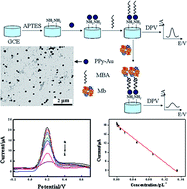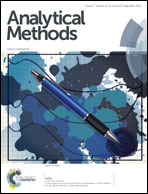One-step green synthesis of a polypyrrole–Au nanocomposite and its application in myoglobin aptasensor†
Abstract
An electrochemical aptasensor was fabricated based on a polypyrrole–Au nanocomposite (PPy–Au NC) and myoglobin-binding aptamer (MBA). The PPy–Au NC was synthesized using a one-step green synthesis method and was characterized by transmission electron microscopy (TEM), UV-vis spectroscopy and a diffuse reflectance spectrum. The studies revealed that the PPy–Au NC provided a mild micro-environment and large surface area for MBA immobilization and facilitated electron transfer. Glassy carbon electrodes (GCEs) surface modified with PPy–Au NC were grafted with MBA, which had excellent binding affinity and selectivity for myoglobin (Mb). The binding of Mb at the modified GCE surface greatly restrained the access of electrons for a redox probe of [Fe(CN)6]3−/4−. Moreover, the aptasensor could be used for the detection of Mb in biochemical assays, with a wide detection range (0.0001 to 0.15 g L−1) and a low detection limit of 30.9 ng mL−1. The aptasensor had a good anti-interference property towards hemin, glucose oxidase (GOx), cytochrome c and hemoglobin. The idea and method presented herein provide a new approach for the evaluation of the freshness and quality of stored meat.


 Please wait while we load your content...
Please wait while we load your content...